 Butter and Eggs
(Linaria vulgaris) also called Yellow Toadflax
Butter and Eggs
(Linaria vulgaris) also called Yellow Toadflax
Wild Flowers of Sleepy Hollow Lake From All-Creatures.org Art and Photo Journals and Galleries Directory
Dedicated to the Preservation and Restoration of the Whole of Creation: Humans - Animals - Environment
"And God saw all that He had made, and behold, it was very good.
And there was evening and there was morning, the sixth day" (Genesis 1:31)
Butter and Eggs (Linaria vulgaris) also called Yellow Toadflax
Table of Contents
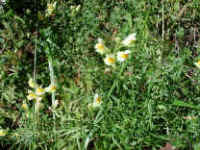
(Butter and Eggs (Linaria vulgaris) - 01)
While on one of our walks, we spotted this small patch of butter-and-eggs wildflowers growing among other
plants. Apparently due to the competition for space, the stems of these
butter-and-eggs wildflowers only developed a few flowers. Where they can grow
"freely", the butter-and-eggs will produce fifteen or more blooms on each
stem. The butter-and-eggs, a member of the Figwort family, usually grow to heights
of one to two feet.
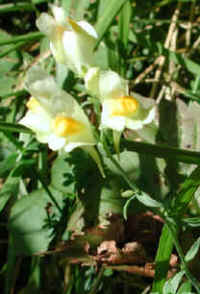
(Butter and Eggs (Linaria vulgaris) - 04)
This is a closer view of one of the butter-and-eggs stems, which looks like it will develop several more flowers
lower on the stem. The literature states that the butter-and-eggs blooms from May
through October, but we didn't spot these until September. There is only one species
of butter-and-eggs which grows all across the northern two-thirds of the United States,
though it is more prevalent in the eastern states. One of the interesting features
of the butter-and-eggs is the closed throat of the flowers which extends below the stem
and calyx, and which are clearly visible on the lower two blooms.
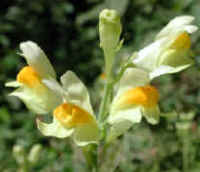
(Butter and Eggs (Linaria vulgaris) - 02)
The butter-and-eggs, a native of Europe, was introduced into North America by the early settlers because of its
many uses: as an ingredient in colonial skin lotion, as a tea made from its leaves to
treat constipation (which they most likely would not have suffered from if they had been
totally vegetarian), and its juice, mixed with milk, was used as a fly poison around
barns.
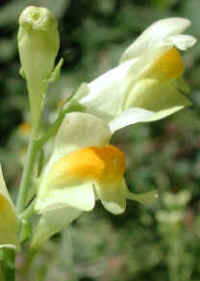
(Butter and Eggs (Linaria vulgaris) - 02a)
This is an enlargement of the previous butter-and-eggs photo to more
clearly show the opening bud at the top of the stem, the way the stem and calyx attach to
the "middle part" of the flower (middle flower), and the closed throat of the
flower extending below the calyx (lower flower). The closed throat is formed by the
lower lip of this 2-lipped flower.
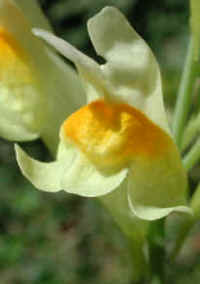
(Butter and Eggs (Linaria vulgaris) - 03)
The actual size of the butter-and-eggs flower is about one inch long from the top of the upper lip to the bottom
of the closed throat, or about one-thirteenth the size of this full-sized photo. The
flower of the butter-and-eggs is formed by a 2-lipped corolla which is spurred at the
base. The upper lip has two lobes which stand erect. The lower lip has three
lobes with an orange colored base which close the throat. The butter-and-eggs, at
close inspection, seems to have a hairy "tongue" resting on the top of the lower
lip. We find ourselves constantly thanking God for little wonders, such as the
butter-and-eggs, which bring joy to our souls. Let us work together to protect and
preserve all that God has given us.
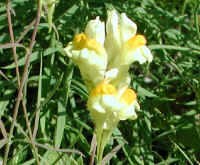
(Butter and Eggs (Linaria vulgaris) - 05)
As we were taking one of our walks, we came upon another small patch of butter
and eggs. God's creation is filled with never ending beauty, if we will
only take the time to see it; and we can see it during every season of the year.
The butter and eggs are just one of the beauty "spots" which appear from late
spring to early fall.
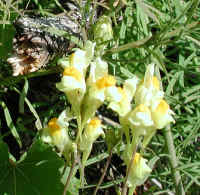
(Butter and Eggs (Linaria vulgaris) - 05a)
The broken, decomposing tree branch adds an interesting contrast to these butter
and eggs that were growing on the edge of a field beside the road.
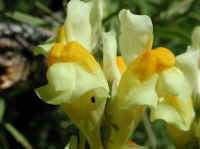
(Butter and Eggs (Linaria vulgaris) - 06)
This is a closer look at one of the butter and eggs flower clusters.
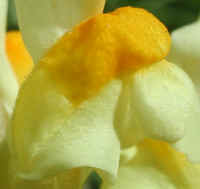
(Butter and Eggs (Linaria vulgaris) - 06a)
One of the things we really enjoy about doing macro digital photography is that
we get to see parts of God's creation that we couldn't see with the "naked eye".
In this close-up of a single butter and eggs flower, we can see the hairy yellow
tongue and the individual cells that form the petals.
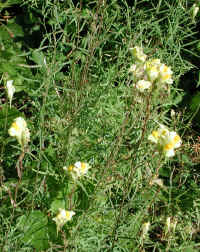
(Butter and Eggs (Linaria vulgaris) - 07)
This normal view of a patch of butter and eggs is in sharp contrast to the
close-up view of macro photography. Both views have their own beauty, if
we just take the time to see all that God has unfolded before us.
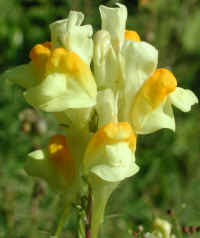
(Butter and Eggs (Linaria vulgaris) - 08)
Before continuing on our walk, we took one last look and photo of a butter and
egg flower cluster. When we learn to truly cherish every aspect of God's
creation, and not destroy it, we will discover the true meaning of peace.
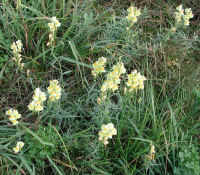
(Butter and Eggs (Linaria vulgaris) - 09)
These butter and eggs were growing in a grassy field. They were quite
short, which according to our observations, appears to be a common trait of
wildflowers that grow in places where they are mowed. When mowed down,
they seem to be genetically programmed to bloom rapidly without reaching full
height, as a means of preserving the species.
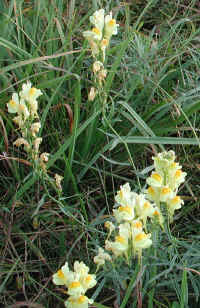
(Butter and Eggs (Linaria vulgaris) - 10)
At the top of this photo, the lower flowers on two butter and eggs are
already withering and going to seed, while others are in full bloom.
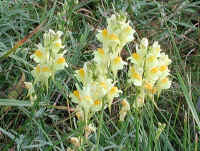
(Butter and Eggs (Linaria vulgaris) - 10a)
This is another cluster of butter and eggs that were growing in the field.
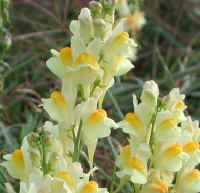
(Butter and Eggs (Linaria vulgaris) - 11)
The flowering racemes of the butter and eggs develop from the ground upward with
the first flowers appearing at the bottom while buds are still forming at the
top. This gives the lower flowers a chance to go to seed, in case the
raceme is cut before it has fully developed.
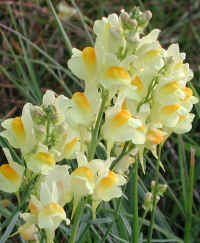
(Butter and Eggs (Linaria vulgaris) - 12)
This is another natural bouquet of butter and eggs that was growing in the
field. A newly developing raceme can be seen at the bottom right of the photo.
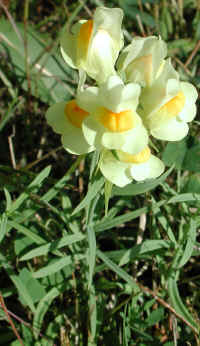
(Butter and Eggs (Linaria vulgaris) - 13)
In this photo of the butter and eggs, we can observe the linear "grass-like"
leaves. The lower leaves grow opposite or whorled, while those higher on
the stem grow alternately.
| Wild Flowers of SHL: Photo Identification, Common Name, Scientific Name | Art and Photos |

 Presented here are just a few of the countless components of God's creation.
Just as we cannot have human and animal life without water and plants, neither
can we have lasting peace without love and compassion. It is our hope and
prayer that this series will motivate people to live and act in a cruelty-free
manner; that we would no longer hurt or destroy each other, the animals or our
environment.
Presented here are just a few of the countless components of God's creation.
Just as we cannot have human and animal life without water and plants, neither
can we have lasting peace without love and compassion. It is our hope and
prayer that this series will motivate people to live and act in a cruelty-free
manner; that we would no longer hurt or destroy each other, the animals or our
environment.






